Twitter, Cisco and Yelp report earnings Tuesday after the bell. Here’s a quick look at how the options market is pricing moves as well as some spread examples in Twitter.
With Twitter (TWTR) trading about $59.50, the options market is pricing an expected move on the week of about 10.5%, corresponding to about $66 for a bullish consensus and $53 bearish, via Options AI:
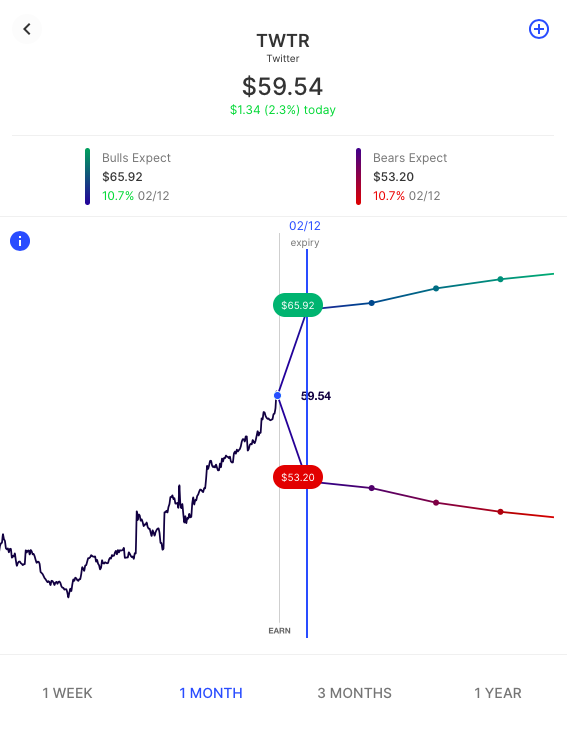
With Cisco (CSCO) trading near $48.50 options are pricing about a 4.5% expected move corresponding to about $50.50 for a bullish consensus and $46.50 for bearish:
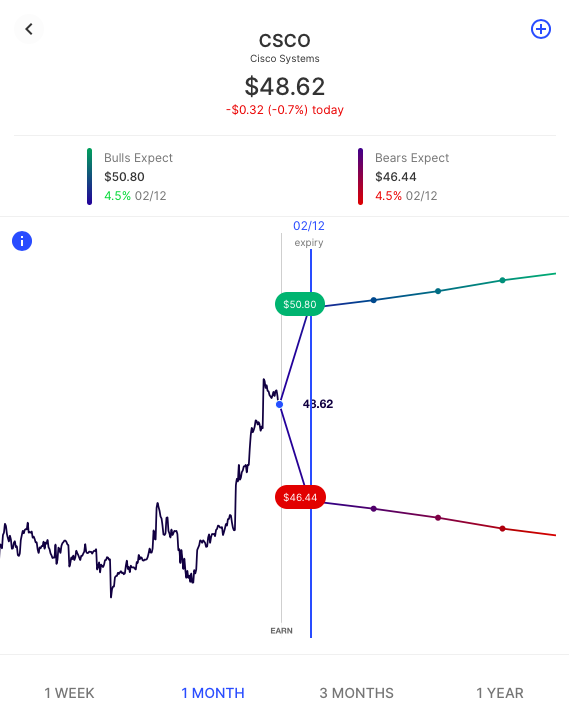
With Yelp! (YELP) trading near $38 options are pricing about a 10% expected move corresponding to about $42 for a bullish consensus and $34.50 for bearish:
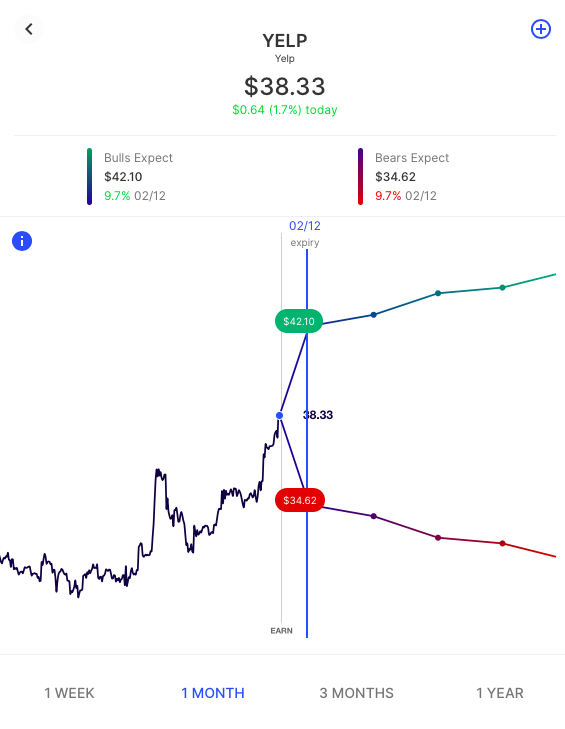
Here we will look at how option spreads might be used to reduce capital outlay and potentially improve probability of profits (versus buying outright calls or puts) and how the expected move can help guide strike selection through this process.
Please note, any stocks and/or trading strategies referenced are for informational and educational purposes only and should in no way be construed as recommendations. The strategies depicted represent just a few of the many potential ways that options might be used to express any particular view. All prices are approximate at the time of writing.
Debit Call Spreads to the Expected Move
Knowing that the options market is pricing a move of about 10% in Twitter this week, let’s assume that a trader is inclined to agree with the crowd – that a move beyond that is indeed, less likely. In this scenario, a trader might look to a Debit Call if bullish, or Debit Put Spread if bearish. Often, a debit spread to the expected move is not much different in cost than an out of the money call or put.
Using TWTR stock, trading near $59.50 at the time of writing, here’s an example of a bullish Debit Call Spread, the +60/-66, expiring Feb 12th. This spread buys an at the money call and simultaneously sells a call at the bullish consensus.
On the chart below, note the breakeven on this strategy, just a few dollars higher than the current stock level:
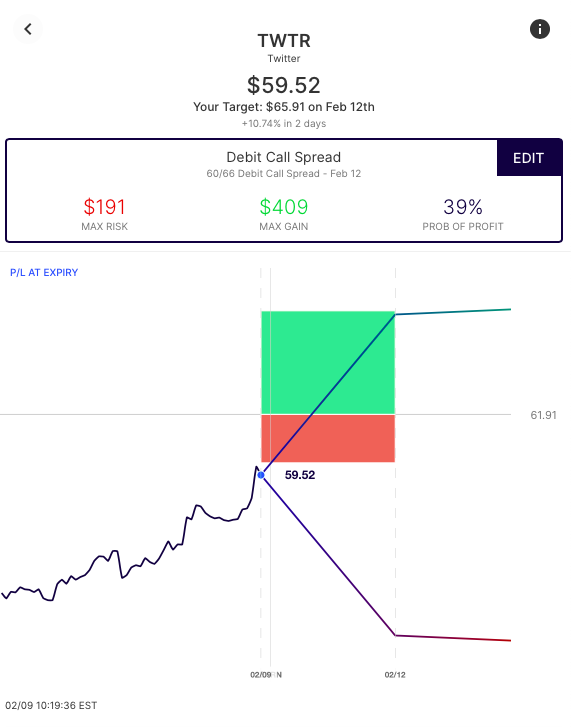
In fact, as one can see with the two strikes, this Debit Spread trades at a cost not too different from the out of the money call (which is being sold as part of the spread). By being a buyer of the spread for 1.90, while selling the out of the money call near 1.70, a trader is able to establish a much lower breakeven than buying that out of the money call outright, for just .20 more in cost:
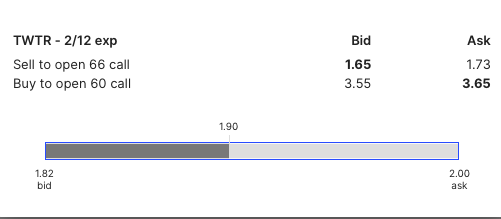
This example is for bullish debit spreads, but the same concept applies for bearish debit put spreads.
Credit Spreads: ‘Selling to the Bulls’
Again, using TWTR as an example, traders can also trade directionally, but with a credit received.
Using a bearish positioning in TWTR, we can see a put and a debit put spread, but also two examples of Credit Call Spreads:
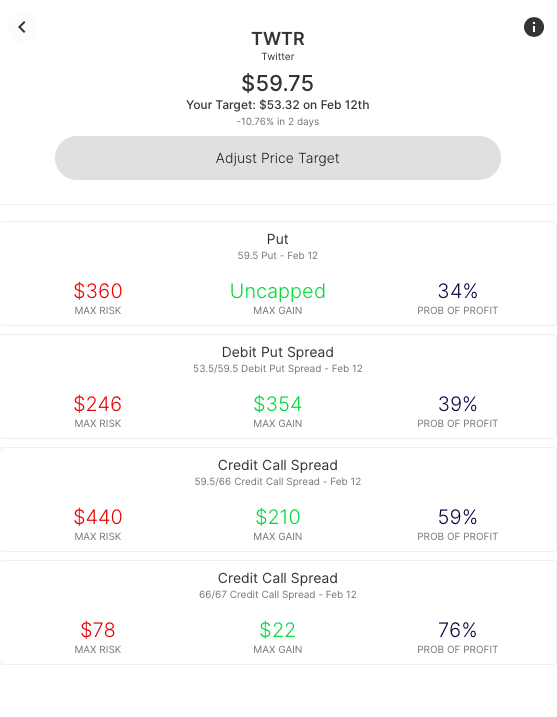
The third trade on the list is an at-the-money Credit Call Spread (-59.50/+66 that takes a view that the stock will simply be lower by Friday. Any close in the stock below 59.50 and the trade is worthless, and the credit is kept. The fourth trade strategy shown is an out-of-the-money Credit Call Spread (-66/+67) reflecting a view that even if the stock is higher, it will not be above the bullish expected move. Any close in the stock below 66 on expiry and the credit is kept.
Both trades risk the difference between the credit received for the trade, and the width of the spread. For instance, the out of the money credit call spread is risking $78 to make $22.
Selling to both the Bulls and the Bears
Finally, let’s consider the scenario where a trader believes the options market is overpricing the move entirely and that the stock will stay within the expected move (in either direction). Rather than selling a credit spread to be “not bearish” or “not bullish”, a trader can ‘sell the move’ to both the bulls and the bears. Here’s an example in Twitter, using the stock’s expected move to initially set strikes for an Iron Condor, simultaneously selling an out-of-the-money credit call spread, and an out-of-the-money credit put spread:
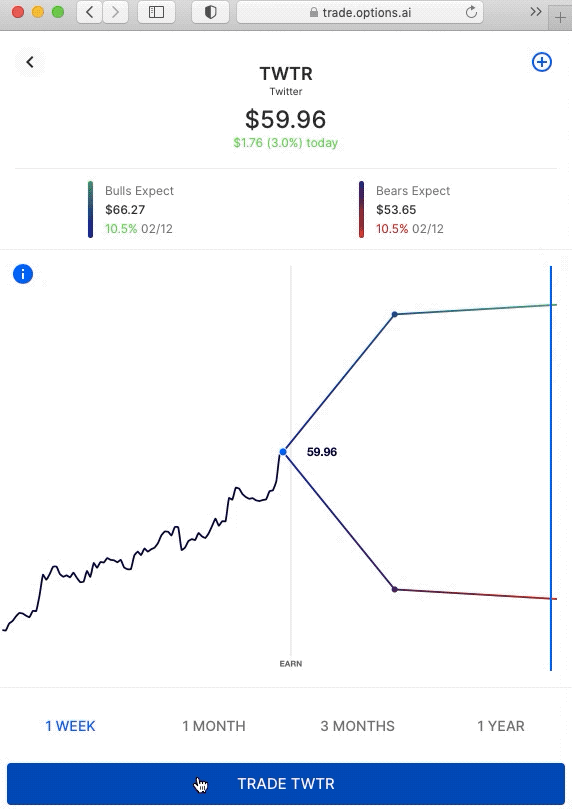
Note the range created on the chart within the expected move. The Iron condor, seeks to collect the premium (income) received if TWTR stays within the expected move. It is a higher probability of profit trade, that in this case is about a 3 to 2 risk/reward. It is at max loss if the stock moves beyond the outer range of the trade, but it is defined risk.
Summary
Remember, the above are just examples of the many ways a trader might express a view using options. They are based on where the stock is trading at the time of writing and are intended solely to demonstrate how the expected move can help provide actionable insight to consider before making any trade – particularly into an uncertain event – and how it might be used for more informed strike selection. Learn / Options AI has a couple of free tools, including an earnings calendar with expected moves, as well as education on expected moves and spread trading. The concepts shown in Twitter can apply to any stock and are simply used here for illustrative purposes.


